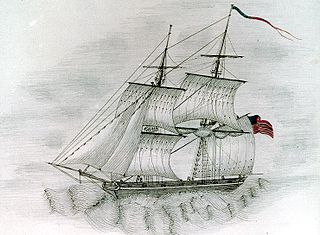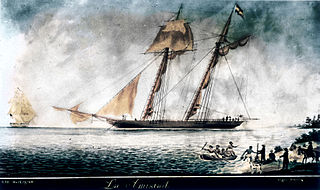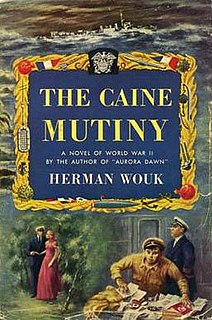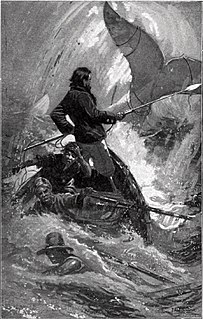
Mutiny is a revolt among a group of people to oppose, change, or overthrow an organization to which they were previously loyal. The term is commonly used for a rebellion among members of the military against an internal force, but it can also sometimes mean any type of rebellion against any force. Mutiny does not necessarily need to refer to a Military Force and can describe a political, economic, or Power structure in which there a change of power.

Treasure Island is an adventure novel by Scottish author Robert Louis Stevenson, narrating a tale of "buccaneers and buried gold." Its influence is enormous on popular perceptions of pirates, including such elements as treasure maps marked with an "X", schooners, the Black Spot, tropical islands, and one-legged seamen bearing parrots on their shoulders.

The Whydah Gally was a fully rigged galley ship that was originally built as a passenger, cargo, and slave ship. On the return leg of its maiden voyage of the triangle trade, the Whydah was captured by the pirate Captain Samuel "Black Sam" Bellamy, beginning a new role in the Golden Age of Piracy.

The second USS Somers was a brig in the United States Navy during the John Tyler administration which became infamous for being the only U.S. Navy ship to undergo a mutiny which led to executions.

The Zong massacre was the mass killing of more than 130 enslaved Africans by the crew of the British slave ship Zong on and in the days following 29 November 1781. The Gregson slave-trading syndicate, based in Liverpool, owned the ship and sailed her in the Atlantic slave trade. As was common business practice, they had taken out insurance on the lives of the enslaved people as cargo. According to the crew, when the ship ran low on drinking water following navigational mistakes, the crew threw enslaved people overboard into the sea.

HMS Defiance was a 74-gun third rate ship of the line of the Royal Navy, built by Randall and Co., at Rotherhithe on the River Thames, and launched on 10 December 1783.

Barry Unsworth FRSL was an English writer known for his historical fiction. He published 17 novels, and was shortlisted for the Booker Prize three times, winning once for the 1992 novel Sacred Hunger.
Benito de Soto Aboal was a Galician pirate, and captain of the Burla Negra.

Storozhevoy was a Soviet Navy 1135 Burevestnik-class anti-submarine frigate. The ship was attached to the Soviet Baltic Fleet and based in Baltiysk. It was involved in a mutiny led by Valery Sablin in November 1975.

Slave ships were large cargo ships specially built or converted from the 17th to the 19th century for transporting slaves. Such ships were also known as "Guineamen" because the trade involved human trafficking to and from the Guinea coast in West Africa.

Mutiny on the Bounty is a 1935 Metro-Goldwyn-Mayer drama film directed by Frank Lloyd and starring Charles Laughton and Clark Gable, based on the 1932 Charles Nordhoff and James Norman Hall novel Mutiny on the Bounty.

Mutiny on the Bounty is a 1962 American Technicolor epic historical drama film released by Metro-Goldwyn-Mayer, directed by Lewis Milestone and starring Marlon Brando, Trevor Howard and Richard Harris. The screenplay was written by Charles Lederer, based on the novel Mutiny on the Bounty by Charles Nordhoff and James Norman Hall. Bronisław Kaper composed the score.

La Amistad was a 19th-century two-masted schooner, owned by a Spaniard living in Cuba. It became renowned in July 1839 for a slave revolt by Mende captives, who had been captured by Portuguese slave hunters in Sierra Leone and brought to Cuba. Two Spanish plantation owners, Don José Ruiz and Don Pedro Montes, bought 53 captives in Havana, Cuba and were transporting them on the ship to their plantations near Puerto Príncipe. The revolt began after the schooner's cook jokingly told the slaves that they were to be "killed, salted, and cooked". Sengbe Pieh, a Mende man, also known as Joseph Cinqué, unshackled himself and the others on the third day and started the revolt. They took control of the ship, killing the captain and the cook. In the melee, three Africans were also killed.

The Caine Mutiny is the 1951 Pulitzer Prize-winning novel by Herman Wouk. The novel grew out of Wouk's personal experiences aboard two destroyer-minesweepers in the Pacific Theater in World War II. Among its themes, it deals with the moral and ethical decisions made at sea by ship captains. The mutiny of the title is legalistic, not violent, and takes place during Typhoon Cobra, in December 1944. The court-martial that results provides the dramatic climax to the plot.

Sacred Hunger is a historical novel by Barry Unsworth first published in 1992. It shared the Booker Prize that year with Michael Ondaatje's The English Patient.
Thomas Ellison was an able seaman on His Majesty's Armed Ship Bounty. After participating in the Mutiny on the Bounty on 28 April 1789, he remained in Tahiti rather than continuing on to the Pitcairn Islands with the inner core of the mutineers, and in 1791 voluntarily turned himself in to the seamen of HMS Pandora to face justice in England. He was court-martialed at Spithead in September 1792, sentenced to death, and hanged on 29 October. Questions continue as to the degree of Ellison's culpability in the mutiny.

Piracy was a phenomenon that was not limited to the Caribbean region. Golden Age pirates roamed off the coast of North America, Africa and the Caribbean.
Norfolk Island convict mutinies were a series of armed uprisings by convicts on the penal colony of Norfolk Island. All were unsuccessful.

Nautical fiction, frequently also naval fiction, sea fiction, naval adventure fiction or maritime fiction, is a genre of literature with a setting on or near the sea, that focuses on the human relationship to the sea and sea voyages and highlights nautical culture in these environments. The settings of nautical fiction vary greatly, including merchant ships, liners, naval ships, fishing vessels, life boats, etc., along with sea ports and fishing villages. When describing nautical fiction, scholars most frequently refer to novels, novellas, and short stories, sometimes under the name of sea novels or sea stories. These works are sometimes adapted for the theatre, film and television.
HMS Revenge (1741) was a privateering vessel commissioned by Governor of Rhode Island, Richard Ward in 1741. In his Letter of Marque, Ward names Benjamin Norton as captain, commanding him to commandeer any Spanish ship he may come across. Throughout the sloop's five month cruise, Norton kept a detailed journal of the ship's daily encounters. The ship was set to sail down the East Coast of the colonies to the Caribbean, and stop any Spanish ships from delivering supplies, or taking supplies.
















